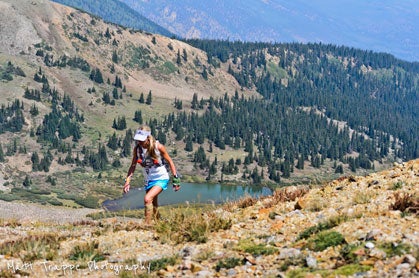Beyond 26.2 on Dirt

Five tips to not only survive but happily finish your first ultra
Photo by Matt Trappe
Tina Lewis on her way to winning Colorado’s 2012 Leadville Trail 100-Miler.
Running your first trail ultramarathon can be intimidating. After all, many trail ultras are advertised as gnarly, dangerous events not intended for (yes, here comes a cliché) “the faint of heart.” And let’s be honest, the marathon’s plenty hard. Throw in another six miles for a 50K, rocks and roots and, often times, challenging climbs and descents, and trail ultrarunning can sound hardcore. But, it doesn’t have to be. Here, we’ve compiled five tips from both beginning and experienced ultrarunners to help you run your first ultra with confidence and finish strong.
1. Break the race into small sections.
Whether you’re running 32 miles or 100 miles, the distance may be hard to chew. Trail Runner Subscriptions Manager, Jen Burn, suggests breaking the race up into smaller segments. This could mean thinking of a 50K, for example, as four sets of eight miles. Or do what Jen does, and simply run from aid station to aid station.
“Running from aid station to aid station, I was able to mentally break up the distance into something more manageable,” she says of her first-ever ultra, the Silver Rush 50 Mile in Leadville, Colorado, earlier this year. “This tactic gave me a concrete place to focus on early in the race and I still had an overwhelming amount of mileage left to run.”
Segmenting the race in small pieces prevents you from getting intimidated and wasting mental energy. If you only have to focus on eight miles at a time for example (or even four!), you’re more likely to stay calm, relaxed and focused.
2. Expect the unexpected.
You’ve probably heard the saying, “Anything can happen in an ultra.” While this is undoubtedly true with the 100-mile distance, the same holds true for a 50K. A myriad of issues may affect your race, including weather, terrain, competition, stomach issues and cramps, to name a few.
According to 2011 The North Face Endurance Challenge Championship winner, Mike Wolfe, of Missoula, Montana, “Don’t over-analyze before going into a race. Many first timers go in over-prepared with splits memorized, food strategized by the minute, etcetera. You cannot plan out what will happen in an ultra. When your plan inevitably crumbles, and it will at some point during a race even if only for a few minutes, some people lose it mentally.”
He continues, “Go into your first ultra with a more relaxed approach: have a plan, but know it will likely need to change. Be flexible mentally and expect the unexpected. Your body will adapt.”
3. Listen to your body.
Above all, though, listen to your body’s signals. According to elite ultrarunnner Nikki Kimball, of Bozeman, Montana, glean information from experienced ultrarunners , but, she warns, “Remember, there is much individual difference between athletes. What assists one runner may not be tolerated by another.”
For example, just because your friend Jerry eats bacon sandwiches and avocados while he runs 100s and claims that they are the best ultraunning fuel, it doesn’t mean that your stomach will be able to tolerate such a high-fat food. Try it on a training run first. Use trial and error to find your ideal race-day food.
4. Keep pouring fuel in the tank.
To reach the finish line, you’ll need to fuel up during the race. This means eating (whether that’s gels, liquid calories or actual whole foods), hydrating and replenishing electrolytes. Says 2012 Leadville 100-Mile women’s winner, Tina Lewis, “Eat and drink as much as you can through the entire race as soon as the gun goes off.”
Jen Burn recommends setting an alarm every 25 to 30 minutes to remind you to take a gel. While “on demand” eating isn’t necessarily right for everyone, practice eating and drinking during training to find the method that best helps you get calories throughout the race.
5. Find a reason to finish.
Perhaps the most important advice for finishing your first ultra is just that: finish your first ultra. While this may seem simple, going into race day with a “we’ll see how it goes” attitude may lead you to a DNF.
Before the inaugural Run Rabbit Run 100 Mile in Steamboat Springs, Colorado, race director Fred Abramowitz told a room full of race entrants, “You are not all going to finish. Some of you are going to have good reasons for DNFing and others not so good reasons. One hundred miles is a long way and the only way you’re going to finish is if you find a reason to finish. I don’t care if it’s as simple as telling yourself that you don’t want to show up to work on Monday and explain to your co-workers that you dropped out of a race. Find a reason and believe it.”
No doubt, running your first ultra is going to be hard. But you already knew that. You’re going to suffer, and, at times, you’re going to want to quit. But decide why you’re going to persevere and repeat it to yourself over and over when you get tired and feel like giving up.